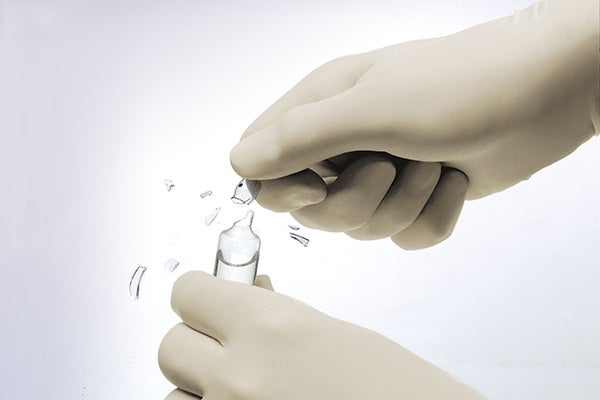No content results match your keyword.
Content
You have successfully logged out.
Not registered yet?
Particulate Contamination in Pediatrics & Neonatology
Particulate contamination is the unintended presence of extraneous, mobile, and undissolved particles in parenteral solutions.3, 4
Causes of particulate contamination are primarily drugs that are present in various containers (e.g., vials, ampoules, pre-filled containers, and premixed solutions). Many types of particulate contamination derive from glass, plastic, rubber and/or undissolved solids. These particles can vary in size and may cause serious damage to neonatal and pediatric patients.

Infused particles are known as an additional risk for intensive care patients.5 They increase the risk of thrombosis, impaired microcirculation and modulated immune response.6
For children and neonates, the risk of particulate contamination is particularly high.
Several studies have reported the consequences for critically ill children. The infusion of particles in children:
Neonates in the intensive care unit are particularly at risk because of their physiological condition and the fact that they are frequently administered multiple injectable drugs simultaneously. Even very low amounts of liquid may lead to incomplete drug dissolution and increase the risk of drug incompatibility.11
In neonates, the infusion of particles may increase complications such as inflammation, sepsis, and enterocolitis.12
Compared to adults, injecting particulate matter into pediatric patients has a more drastic effect. One reason for this could be the difference in cardiovascular characteristics. Neonates have a smaller number and diameter of blood vessels in the pulmonary capillaries.13, 14
To reduce the risk of particulate contamination, pay attention to the following:
The British Pharmaceutical Nutrition Group (BPNG) recommends that appropriate filters should be used when administering parenteral nutrition to immunocompromised patients such as children and neonates to avoid contamination with insoluble particles.15
Inline filters have been suggested to limit the load of particles infused through central venous lines and to prevent bacterial and endotoxin infusion.16
Inline filtration can reduce the incidence of severe complications caused by particulate contamination in critically ill pediatric and neonatal patients, such as SIRS (systemic inflammatory response syndrome), sepsis, circulatory failure, ARDS (acute respiratory distress syndrome), thrombosis, acute renal and acute liver failure.
The overall complication rate of these severe events was reduced by 10% (from 40.9% to 30.9%) when IV filters were used.17
*Applies to Intrapur® filters in our portfolio
Process standardization can prevent severe complications in intensive care and increase patient safety. Include the use of appropriate filters in your regular pediatric and neonatal ICU workflow to minimize the risk of particulate contamination in your pediatric and neonatal patients.
In addition to reduced morbidity for pediatric patients, reducing particle contamination also shortens length of stay and duration of mechanical ventilation.17 As a result, young patients can be discharged earlier from the ICU and return home to their families sooner to simply grow up and be children.
Pediatrics & Neonatology
1. Mehrkens HH, Klaus E, Schmitz JE. Possibilities of material contamination due to additional injections. Klin Anasthesiol Intensivther. 1977;14:106-13.
2. Walpot H, Franke RP, Burchard WG, Agternkamp C, Müller FG, Mittermayer C, Kalff G. Particulate contamination of infusion solutions and drug additives within the scope of long-term intensive therapy. 1. Energy dispersion electron images in the scanning electron microscope-REM/EDC. Anasthesist. 1989;38(10):544-8.
3. Werner BP, Winter G. (2015) Particle contamination of parenteralia and in-line filtration of proteinaceous drugs. Int J Pharm;496(2):250-67
4. Doessegger L, Mahler HC, Szczesny P, Rockstroh H, Kallmeyer G, Langenkamp A, Herrmann J, Famulare J. (2012) The potential clinical relevance of visible particles in parenteral drugs. J Pharm Sci; 101(8): 2635-44
5. Jack T. Micro Particles Contamination. Innocent Bystander or Real Threat? 2012 (Presentation: „_Micro Particles Contamination_Jack_MHH_2012“).
6. Boehne M, Jack T, Köditz H, Seidemann K, Schmidt F, Abura M, Bertram H, Sasse M. In-line filtration minimizes organ dysfunction: new aspects from a prospective, randomized, controlled trial. BMC Pediatr. 2013;13:21.
7. Puntis JW, Wilkins KM, Ball PA, Rushton DI, Booth IW. Hazards of parenteral treatment: do particles count? Arch Dis Child 1992 Dec;67(12):1475–7.
8. Breaux CW, Duke D, Georgeson KE, Mestre JR. Calcium phosphate crystal occlusion of central venous catheters used for total parenteral nutrition in infants and children: prevention and treatment. J Pediatr Surg 1987 Sep;22(9):829–32.
9. Bradley JS, Wassel RT, Lee L, Nambiar S. Intravenous ceftriaxone and calcium in the neonate: assessing the risk for cardiopulmonary adverse events. Pediatrics 2009 Apr;123(4):e609–13.
10. Monte SV, Prescott WA, Johnson KK, Kuhman L, Paladino JA. Safety of ceftriaxone sodium at extremes of age. Expert Opin Drug Saf 2008 Sep;7(5):515–23.
11. Perez M, Maiguy-Foinard A, Barthélémy C, Décaudin B, Odou P. Particulate Matter in Injectable Drugs: Evaluation of Risks to Patients. Pharmaceutical Technology in Hospital Pharmacy 2016;1(2):91-103.
12. Van Lingen RA, Baerts W, Marquering ACM, Rujis GJHM. The use of in-line filtration in sick newborn infants. Acta paediatrica 2004; 93:1-5.
13. Heyman S. Toxicity and safety factors associated with lung perfusion studies with radiolabeled particles. J Nucl Med Off Publ Soc Nucl Med 1979 Oct;20(10):1098–9.
14. Lofthus RM, Srebnik HH. The physical dimensions of the human neonatal cardiovascular system. J Biomech Eng 1987 Nov;109(4):336–9.
15. Bethune K Allwood M, Grainger C, Wormleighton C; British Pharmaceutical Nutrition Group Working Party. (2001) Use of filters during the preparation and administration of parenteral nutrition: position paper and guidelines prepared by a British pharmaceutical nutrition group working party. Nutrition;17(5):403-8.
16. Virlouvet AL, Pansiot J, Toumazi A et al. In-line filtration in very preterm neonates: a randomized controlled trial. Sci Rep 2020; 10(5003).
17. Jack T, Boehne M, Brent BE, Hoy L, Köditz H, Wessel A, Sasse M. In-line filtration reduces severe complications and length of stay on pediatric intensive care unit: a prospective, randomized, controlled trial. Intensive Care Med. 2012; 38:1008–1016.
Your feedback matters! Participate in our customer survey to help us enhance our website, products and services. Thank you for your support!